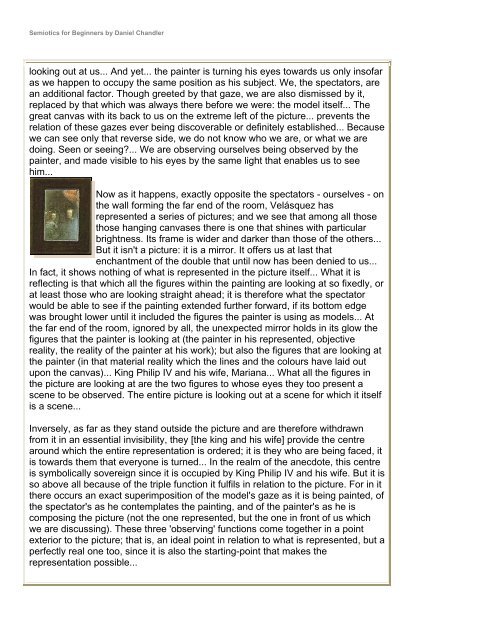Semiotics for Beginners by Daniel Chandler
Semiotics for Beginners by Daniel Chandler
Semiotics for Beginners by Daniel Chandler
You also want an ePaper? Increase the reach of your titles
YUMPU automatically turns print PDFs into web optimized ePapers that Google loves.
<strong>Semiotics</strong> <strong>for</strong> <strong>Beginners</strong> <strong>by</strong> <strong>Daniel</strong> <strong>Chandler</strong><br />
looking out at us... And yet... the painter is turning his eyes towards us only insofar<br />
as we happen to occupy the same position as his subject. We, the spectators, are<br />
an additional factor. Though greeted <strong>by</strong> that gaze, we are also dismissed <strong>by</strong> it,<br />
replaced <strong>by</strong> that which was always there be<strong>for</strong>e we were: the model itself... The<br />
great canvas with its back to us on the extreme left of the picture... prevents the<br />
relation of these gazes ever being discoverable or definitely established... Because<br />
we can see only that reverse side, we do not know who we are, or what we are<br />
doing. Seen or seeing?... We are observing ourselves being observed <strong>by</strong> the<br />
painter, and made visible to his eyes <strong>by</strong> the same light that enables us to see<br />
him...<br />
Now as it happens, exactly opposite the spectators - ourselves - on<br />
the wall <strong>for</strong>ming the far end of the room, Velásquez has<br />
represented a series of pictures; and we see that among all those<br />
those hanging canvases there is one that shines with particular<br />
brightness. Its frame is wider and darker than those of the others...<br />
But it isn't a picture: it is a mirror. It offers us at last that<br />
enchantment of the double that until now has been denied to us...<br />
In fact, it shows nothing of what is represented in the picture itself... What it is<br />
reflecting is that which all the figures within the painting are looking at so fixedly, or<br />
at least those who are looking straight ahead; it is there<strong>for</strong>e what the spectator<br />
would be able to see if the painting extended further <strong>for</strong>ward, if its bottom edge<br />
was brought lower until it included the figures the painter is using as models... At<br />
the far end of the room, ignored <strong>by</strong> all, the unexpected mirror holds in its glow the<br />
figures that the painter is looking at (the painter in his represented, objective<br />
reality, the reality of the painter at his work); but also the figures that are looking at<br />
the painter (in that material reality which the lines and the colours have laid out<br />
upon the canvas)... King Philip IV and his wife, Mariana... What all the figures in<br />
the picture are looking at are the two figures to whose eyes they too present a<br />
scene to be observed. The entire picture is looking out at a scene <strong>for</strong> which it itself<br />
is a scene...<br />
Inversely, as far as they stand outside the picture and are there<strong>for</strong>e withdrawn<br />
from it in an essential invisibility, they [the king and his wife] provide the centre<br />
around which the entire representation is ordered; it is they who are being faced, it<br />
is towards them that everyone is turned... In the realm of the anecdote, this centre<br />
is symbolically sovereign since it is occupied <strong>by</strong> King Philip IV and his wife. But it is<br />
so above all because of the triple function it fulfils in relation to the picture. For in it<br />
there occurs an exact superimposition of the model's gaze as it is being painted, of<br />
the spectator's as he contemplates the painting, and of the painter's as he is<br />
composing the picture (not the one represented, but the one in front of us which<br />
we are discussing). These three 'observing' functions come together in a point<br />
exterior to the picture; that is, an ideal point in relation to what is represented, but a<br />
perfectly real one too, since it is also the starting-point that makes the<br />
representation possible...




